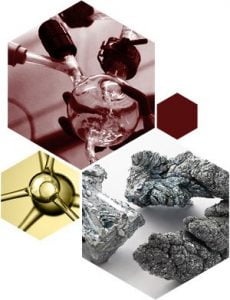
Cobalt (II) Acetate Tetrahydrate
Properties

- We can offer items in bulk or custom. For other quantities or purities, please request a quotation.
- All prices are subject to change.
Related Products
Information about Cobalt (II) Acetate Tetrahydrate / CAS 6147-53-1
Cobalt (II) Acetate Tetrahydrate is a dark red crystalline material, and a deep pink powder in its anhydrous form. This material is also known as Cobaltous Acetate. Like other acetate salts, it is soluble in water, making it a valuable Cobalt precursor. It also decomposes to Cobalt (II) Oxide (CoO) above the relatively low temperature of 310° Celsius. Thus, it is used in the production of cobalt-based materials such as pigments, catalysts, and electroplating.
Cobalt (II) acetate tetrahydrate, being water-soluble, is used to impregnate silica for catalytic materials, as demonstrated by researchers from the National Institute of Materials and Chemical Research in Japan. They enhanced catalytic activity by adding noble metal precursors and modifying the material with alkali and alkaline earth cations. This material successfully catalyzed reactions like carbon monoxide hydrogenation and ethene hydroformylation.
Cobaltous Acetate is also used to produce pigments, such as Cobalt Aluminum Oxide (Co2AlO4 and CoAl2O4), with a freeze-drying method and calcination at varying temperatures. Additionally, it is used in electroplating, as shown by researchers from Banaras Hindu University, who created smooth, fine-grained, and adherent Cobalt deposits using a mixture of Cobalt Acetate and other chemicals.
- Matsuzaki, T., Takeuchi, K., Hanaoka, T., Arakawa, H., & Sugi, Y. (1996). Hydrogenation of carbon monoxide over highly dispersed cobalt catalysts derived from cobalt(II) acetate. Catalysis Today, 28(3), 251–259. https://doi.org/10.1016/0920-5861(95)00245-6
- Grimes, R. W., & Fitch, A. N. (1991). Thermal decomposition of cobalt(II) acetate tetrahydrate studied with time-resolved neutron diffraction and thermogravimetric analysis. Journal of Materials Chemistry, 1(3), 461–468. https://doi.org/10.1039/JM9910100461
- Xi, X., Nie, Z., Ma, L., Li, L., Xu, X., & Zuo, T. (2012). Synthesis and characterization of ultrafine Co2AlO4 pigment by freeze–drying. Powder Technology, 226, 114–116. https://doi.org/10.1016/J.POWTEC.2012.04.029
- Singh, V. B., & Tikoo, P. K. (1977). Electrodeposition of ternary nickel—iron—cobalt alloys from acetate bath. Electrochimica Acta, 22(10), 1201–1204. https://doi.org/10.1016/0013-4686(77)80062-5
Safety
- H302 Harmful if swallowed.
- H317 May cause an allergic skin reaction.
- H334 May cause allergy or asthma symptoms or breathing difficulties if inhaled.
- H341 Suspected of causing genetic defects.
- H350 May cause cancer.
- H360 May damage fertility or the unborn child.
- H410 Very toxic to aquatic life with long lasting effects.
- P201 Obtain special instructions before use.
- P202 Do not handle until all safety precautions have been read and understood.
- P261 Avoid breathing dust/fume/gas/mist/vapours/spray.
- P270 Do not eat, drink or smoke when using this product.
- P272 Contaminated work clothing should not be allowed out of the workplace.
- P280 Wear protective gloves/protective clothing/eye protection/face protection.
- P284 Wear respiratory protection.
- P301+P312 IF SWALLOWED: call a POISON CENTER or doctor/physician IF you feel unwell.
- P302+P352 IF ON SKIN: wash with plenty of soap and water.
- P304+P341 IF INHALED: If breathing is difficult, remove victim to fresh air and keep at rest in a position comfortable for breathing.
- P305+P351+P338 IF IN EYES: Rinse cautiously with water for several minutes. Remove contact lenses, if present and easy to do. Continue rinsing.
- P342+P311 IF experiencing respiratory symptoms: call a POISON CENTER or doctor/physician.
- P362 Take off contaminated clothing and wash before reuse.




